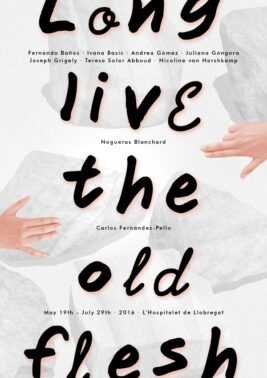Andrea Gómez participates at “Long live the old flesh”

David Cronenberg’s Videodrome (1983) is probably one of the most iconic pieces of lo-fi cyberpunk of
the 1980’s. To a certain extent, we could argue that the famous line uttered at the end of the movie by the protagonist, Max Renn, is key to understanding how the semiotics of video had already moved beyond
the prescient minds of artists like Paik and into the domestic masses. The all-pervasive culture of the image, the birth of digital virtual reality and even perhaps the rise of visual studies, all owe a great deal to this “long live the new flesh” that Renn calls out, right before shooting himself, transmuting his material self into pure visual trascendence.
Since then we’ve been trying to come to terms with this unleashed death-drive of “e-mages”, ever more powerful than their mechanical counterpart, beating with a digital erotism. Today we might attach to images in a more hygienic way than Cronenberg’s gory protheses, but this in no way diminishes their orgastic spell: quite the contrary, in the making of this new flesh of the gaze, we’ve developed a taste for further ghost limbs, for inexistent organs, that deform and haunt the obvious piece of meat effaced by Renn’s symbolic sacrifice: the body.
The more we step into this utopia of pure visual lust, the more we understand that the flesh of profound today is unsurprisingly old and primordial, embedded in the magical tradition of the “word of command”:
in the era of the image we are increasingly becoming more text and more word than ever; not just embodying text, but becoming embodied by its space; not like in a fixed document, but as in “real time”.
Textual materialism has traditionally studied the materiality of the linguistic signifier; not semiotics
but the physical variations of the letter, the page,
the book, and also the social and performative implications that surround editions, publishing and corrections. In recent years, and with the advent of digital text, this materiality, this flesh of the text, has of course been expanded to comprise something else than simple physicality: email may be no different than a good old letter, for sure, but instant messaging and social media redefine our notion of textual presence. We might not be woven to a gun, just like Renn is, but we are certainly woven to our ubiquitous keyboard prosthetics. Text is thus reunited with its etymology of tissue and its “old flesh” re-emerges as a contemporary phenomenon that asks: What sort of dark matter gives text its flesh today?
With the question in mind, I propose a selection of works that explore the “thingness” and the tissues
of language, thinking of the “tongue” not only as a cultural idiomatic expression but as a muscle of the body. Through the use of ineffable oral performances and buccal materialities, these authors pose how elusive and asemic the old flesh of the text may be.
Ivana Basic
Andrea Gómez
Juliana Góngora
Joseph Grigely
Teresa Solar Abboud
Nicoline van Harskamp
—
Curator:
Carlos Fernandez-Pello
Date: Opening 19th May – 29th July
Time: 19h
Place: Nogueras Blanchard Gallery, L’Hospitalet de Llobregat
Categories: Activities of the residents, News |
